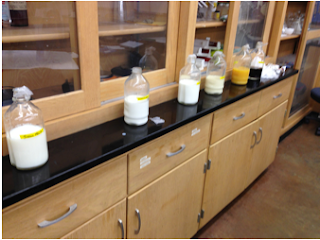Access the quiz at: https://docs.google.com/file/d/0B_nnOJLj_iJAaFVCUWxHelRvM1E/edit?usp=sharing
Question 1 Answer:
The whole picture shows the evolution of a species of whales.
Mesonychid: mammal that lived on land, with 4 limbs to move and search for food.
Ambulocetus: Evolved from Mesonychid. It has a flatter head with a slightly longer and more sharp-triangular mouth. Its limbs adapted to amphibian like arms and legs, allowing it to traverse both on land and water to search for food. A closer inspection also reveals that the Ambulocetus has eyes which are closer to the sides of its head, this allowed the species to have better vision in water.
Rodhocetus: Evolved from Ambulocetus. The most significant change was the whole structure of the Rodhocetus is more water dynamic, along with the change of limbs to fins (limbs were not needed in water), and the splitting of the tail into 2 (gives balance when swimming),
Basilosaurus: Evolved from Rodhocetus. The body evolved even more water dynamic, its fins grew smaller as it had a long and huge tail which would propel it through water.
Question 2 Answer:
E
Question 3 Answer:
All of the three animals have wings, and can fly. Bats are different in that they have finger bones; Birds have one single limb; whilst dragon flys have none. Birds also have strong feet, which allow them to stand. The dragonfly is the only animal out of the three that has a long tail, which it uses for balancing in flight. Birds and bats do not need a tail.
Question 4 Answer:
Differences between the strand of cytochrome C between different species show their similarity. As creatures mutate over time, the more different 2 creatures are from each other the more different their DNAs will change, thus the more differences there will be in the sequences of cytochrome C. Humans and chimpanzees have only 1 difference in their cytochrome C amino acid strands...they are very closely related.
Question 5 Answer:
Titaaliks and fishes, modern day whales and the Rodhocetus all share common ancestors. Homology shows the relationship between the 2 species' structures and genes.
Question 1 Answer:
The whole picture shows the evolution of a species of whales.
Mesonychid: mammal that lived on land, with 4 limbs to move and search for food.
Ambulocetus: Evolved from Mesonychid. It has a flatter head with a slightly longer and more sharp-triangular mouth. Its limbs adapted to amphibian like arms and legs, allowing it to traverse both on land and water to search for food. A closer inspection also reveals that the Ambulocetus has eyes which are closer to the sides of its head, this allowed the species to have better vision in water.
Rodhocetus: Evolved from Ambulocetus. The most significant change was the whole structure of the Rodhocetus is more water dynamic, along with the change of limbs to fins (limbs were not needed in water), and the splitting of the tail into 2 (gives balance when swimming),
Basilosaurus: Evolved from Rodhocetus. The body evolved even more water dynamic, its fins grew smaller as it had a long and huge tail which would propel it through water.
Question 2 Answer:
E
Question 3 Answer:
All of the three animals have wings, and can fly. Bats are different in that they have finger bones; Birds have one single limb; whilst dragon flys have none. Birds also have strong feet, which allow them to stand. The dragonfly is the only animal out of the three that has a long tail, which it uses for balancing in flight. Birds and bats do not need a tail.
Question 4 Answer:
Differences between the strand of cytochrome C between different species show their similarity. As creatures mutate over time, the more different 2 creatures are from each other the more different their DNAs will change, thus the more differences there will be in the sequences of cytochrome C. Humans and chimpanzees have only 1 difference in their cytochrome C amino acid strands...they are very closely related.
Question 5 Answer:
Titaaliks and fishes, modern day whales and the Rodhocetus all share common ancestors. Homology shows the relationship between the 2 species' structures and genes.









